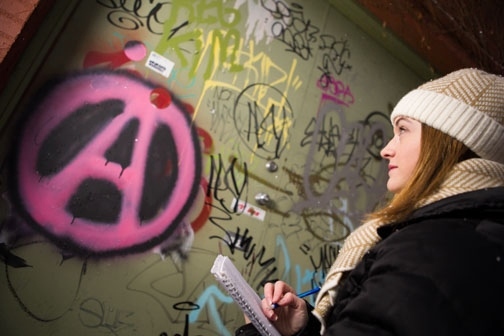Research Winter 2015
Graffiti in Grand Rapids
Geography student receives national recognition for research
by Matthew Makowski
video by Jeremy Knickerbocker
Under bridges, on street corners and on the sides of stores, restaurants and local businesses — these are just some of the many places to find graffiti in the southeast area of Grand Rapids.
Most people pass by these colorful expressions daily without giving them a second thought. That’s not the case for Alyson Mabie, senior geography major.
Since her first semester at Grand Valley in 2013, Mabie has been researching how different graffiti classifications in southeast Grand Rapids reflect cultural shifts in varying neighborhoods over time.\
Mabie said previous studies on graffiti culture and distribution have focused on instances in “mega cities” such as New York City and Los Angeles but her work offers insight into the nature of graffiti in an under-studied location: mid-sized cities.
“When I started telling local people what I was doing they often reacted by saying, ‘Graffiti in Grand Rapids? Good luck with that,’ or ‘You would probably have better luck in Detroit or Chicago,’” Mabie said.

Alyson Mabie examines one of the more than 740 instances of
graffiti she has located in southeast Grand Rapids.
photo by Amanda Pitts
She said her interest in this topic began long before attending Grand Valley. While growing up in the southeast side of Grand Rapids, she saw graffiti in her surroundings and wanted to understand its meanings more thoroughly.
“People see graffiti art and just assume the area is somehow more dangerous,” Mabie said. “This is really where my research interest began. I saw new graffiti in places experiencing growth and renewal. I have learned that graffiti art is not intended to be threatening and it is not reserved for juvenile delinquents with cans of spray paint.”
Mabie began her formal research while attending Grand Rapids Community College prior to being accepted to Grand Valley. Last summer, Mabie’s research at GRCC earned her the Geography Lives! Field Study Grant, which was established to provide promising GRCC geography students with funds to support geographic fieldwork.
Once at Grand Valley, Mabie utilized her coursework, professors’ guidance and available mapping tools to expand her research and collect even more location data.
Mabie’s work ethic and long hours led her to receive a top prize for her research during the East Lakes/West Lakes Regional Conference of the Association of American Geographers in October.
Mabie’s work doesn’t stop with her first place prize, however. She is currently diving deeper into her research with her senior thesis project under the guidance of Roy Cole, assistant professor of geography and planning.
“The senior thesis is going to take the spatial distribution a step further and explore the cultural and demographic undertones of my study area, their change over time and how that relates to the spatial distribution of different graffiti types,” Mabie said.
Cole said Mabie’s research is unique because it combines art and science. “I’ve never had a student with a similar topic,” Cole said. “What’s really interesting to me is her combination of art and science, analyzing artistic expression with the quantitative methods and the spatial science of the geographer.”
Mabie will present her senior thesis at the annual meeting of the Michigan Academy of Science, Arts and Letters at Andrews University in March and the annual meeting of the AAG in Chicago in April.
Categories of Graffiti
Mabie categorizes graffiti in these three sections:
GANG GRAFFITI: symbols specific to a gang and that gang’s “territory.”
GRAFFITI ART: traditional, name-based writing often seen in New York City and Philadelphia in the 1970s.
STREET ART: any graffiti that transcends name-based style, such as murals, stencils and stickers.
